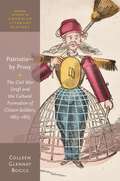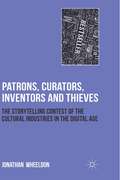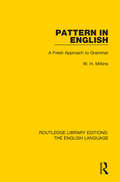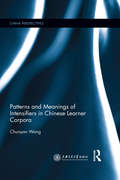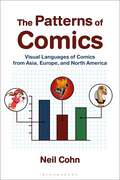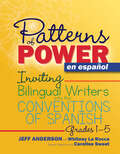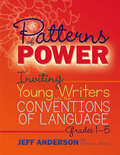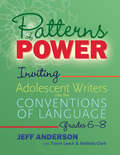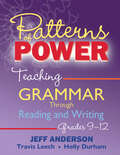- Table View
- List View
Patriotism by Proxy: The Civil War Draft and the Cultural Formation of Citizen-Soldiers, 1863-1865 (Oxford Studies in American Literary History)
by Colleen Glenney BoggsAt the height of the Civil War in 1863, the Union instated the first-ever federal draft. Patriotism By Proxy develops a new understanding of the connections between American literature and American lives by focusing on this historic moment when the military transformed both. Paired with the Emancipation Proclamation, the 1863 draft inaugurated new relationships between the nation and its citizens. A massive bureaucratic undertaking, it redefined the American people as a population, laying bare social divisions as wealthy draftees hired substitutes to serve in their stead. The draft is the context in which American politics met and also transformed into a new kind of biopolitics, and these substitutes reflect the transformation of how the state governed American life. Censorship and the suspension of habeas corpus prohibited free discussions over the draft's significance, making literary devices and genres the primary means for deliberating over the changing meanings of political representation and citizenship. Assembling an extensive textual and visual archive, Patriotism by Proxy examines the draft as a cultural formation that operated at the nexus of political abstraction and embodied specificity, where the definition of national subjectivity was negotiated in the interstices of what it means to be a citizen-soldier. It brings together novels, poems, letters, and newspaper editorials that show how Americans discussed the draft at a time of censorship, and how the federal draft changed the way that Americans related to the state and to each other.
Patriotism by Proxy: The Civil War Draft and the Cultural Formation of Citizen-Soldiers, 1863-1865 (Oxford Studies in American Literary History)
by Colleen Glenney BoggsAt the height of the Civil War in 1863, the Union instated the first-ever federal draft. Patriotism By Proxy develops a new understanding of the connections between American literature and American lives by focusing on this historic moment when the military transformed both. Paired with the Emancipation Proclamation, the 1863 draft inaugurated new relationships between the nation and its citizens. A massive bureaucratic undertaking, it redefined the American people as a population, laying bare social divisions as wealthy draftees hired substitutes to serve in their stead. The draft is the context in which American politics met and also transformed into a new kind of biopolitics, and these substitutes reflect the transformation of how the state governed American life. Censorship and the suspension of habeas corpus prohibited free discussions over the draft's significance, making literary devices and genres the primary means for deliberating over the changing meanings of political representation and citizenship. Assembling an extensive textual and visual archive, Patriotism by Proxy examines the draft as a cultural formation that operated at the nexus of political abstraction and embodied specificity, where the definition of national subjectivity was negotiated in the interstices of what it means to be a citizen-soldier. It brings together novels, poems, letters, and newspaper editorials that show how Americans discussed the draft at a time of censorship, and how the federal draft changed the way that Americans related to the state and to each other.
Patriots
by Peter MorganIf the politicians cannot save Russia, then we businessmen must. We have not just the responsibility but the duty to become Russian heroes.1991. The Fall of the Soviet Union.With the dawning of a new Russia, there are winners and losers, and today's patriot can fast become tomorrow's traitor.As a new generation of oligarchs fights to seize control, we follow billionaire businessman Boris Berezovsky - the 'kingmaker' behind Vladimir Putin - from the president's inner circle to public enemy number one, in this unflinching story of ambition and the dangers of loyalty and love.Peter Morgan's Patriots opened at the Almeida Theatre, London, in July 2022.
Patronage and Poetry in the Islamic World: Social Mobility and Status in the Medieval Middle East and Central Asia (Library of Middle East History)
by Jocelyn SharletPanegyric poetry, in both Arabic and Persian, was one of the most important genres of literature in the medieval Middle East and Central Asia. Jocelyn Sharlet argues that panegyric poetry is important not only because it provides a commentary on society and culture in the medieval Middle East, but also because panegyric writing was one of the key means for individuals to gain social mobility and standing during this period. This is particularly so within the context of patronage, a central feature of social order during these times. Sharlet places the medieval Arabic and Persian panegyric firmly within its cultural context, and identifies it as a crucial way of gaining entry to and movement within this patronage network. Combining medieval poetry, stories, criticism and ethics in Arabic and Persian, Poetry and Patronage in the Islamic World argues that poetry was often used to explore the uncertainty and flexibility of patronage, and to define a cosmopolitan, professional identity that was a key means to gain social mobility. This was particularly crucial given the need to integrate people from diverse backgrounds into the Arabic and Islamic culture of the Abbasid Empire, based in the Middle East, and the Persian and Islamic culture of the Ghaznavid Empire, based in Central Asia. Jocelyn Sharlet discusses medieval perspectives on the problem of poetry, and examines a wide range of stories about poets dealing with the uncertainties of literary patronage. Based on panegyric poetry by the Arabic poets Abu Tammam and al-Buhturi and the Persian poets Farrokhi and Onsori, this book demonstrates that risk in patronage is not restricted to major crises, and shows how uncertainty defines the portrayal of love and political relationships in this poetry. By linking the elaborate rhetoric of panegyric to the broader themes of observation, evaluation, communication and exchange, and how these themes illustrate the uncertainty and flexibility of patronage, this is an important contribution to the fields of pre-modern Middle Eastern and Central Asian literature and culture.
Patrons, Curators, Inventors and Thieves: The Storytelling Contest of the Cultural Industries in the Digital Age
by Jonathan WheeldonJonathan Wheeldon offers a rare and unusually reflective insider account of the transformational challenges of the music industry, and the cultural industries in general, over the past 15 years. He also makes a potentially valuable contribution to loosening the industrial-political deadlock in the debate over copyright reform.
Pattern in English: A Fresh Approach to Grammar (Routledge Library Editions: The English Language)
by W. H. MittinsThis book, first published in 1950, is a collection of what the author felt to be the minimum of English grammar relevant to efficient communication in language. The scope of this title was determined by collecting from children’s writings examples of common faults and weaknesses, and it is through these texts that certain concepts emerged as fundamental, including predication, word-order, proximity, equivalents, variety and repetition. Pattern in English will be of interest to students of English language.
Pattern in English: A Fresh Approach to Grammar (Routledge Library Editions: The English Language)
by W. H. MittinsThis book, first published in 1950, is a collection of what the author felt to be the minimum of English grammar relevant to efficient communication in language. The scope of this title was determined by collecting from children’s writings examples of common faults and weaknesses, and it is through these texts that certain concepts emerged as fundamental, including predication, word-order, proximity, equivalents, variety and repetition. Pattern in English will be of interest to students of English language.
Patterns and Development in the English Clause System: A Corpus-Based Grammatical Overview
by Clarence GreenThis book examines in detail the forms and functions of clause combination in English. Using a corpus linguistics methodology, it describes how the English clause system currently behaves, how it has developed over the history of the language, and how the features and properties of English clause combination have important theoretical and empirical significance. Adopting the cognitive-functional Adaptive Approach to grammar, it offers a series of interconnected studies that investigate how English clause combination interacts with the properties of coherence and cohesion in discourse across historical time, as well in contemporary language use. This work contributes to the ever-increasing common ground between corpus linguistics and cognitive-functional linguistics, producing new paths for interdisciplinary research.
Patterns and Meanings of Intensifiers in Chinese Learner Corpora (China Perspectives)
by Chunyan WangIntensification plays a major role in spoken and written interaction, enabling the writer or speaker to express different levels of commitment. This book explores the patterns and meanings of intensifiers in Chinese learner English by ways of comparison with native English. The study is conducted within the theoretical framework of Firthian contextual theory of meaning, Sinclairian model of Extended Units of Meaning (EUM) and Hunston's pattern grammar. The method of contrastive inter-language analysis (CIA) is adopted and the intensifier collocations in learner English and native English are explored by means of quantitative and qualitative analyses of corpora data. This book is the first attempt to investigate the patterning and meaning features of intensifiers systematically with the corpora data in Chinese learner English. Readers will obtain a relatively complete picture of how Chinese learners use intensifiers to realize their attitudinal meanings.
Patterns and Meanings of Intensifiers in Chinese Learner Corpora (China Perspectives)
by Chunyan WangIntensification plays a major role in spoken and written interaction, enabling the writer or speaker to express different levels of commitment. This book explores the patterns and meanings of intensifiers in Chinese learner English by ways of comparison with native English. The study is conducted within the theoretical framework of Firthian contextual theory of meaning, Sinclairian model of Extended Units of Meaning (EUM) and Hunston's pattern grammar. The method of contrastive inter-language analysis (CIA) is adopted and the intensifier collocations in learner English and native English are explored by means of quantitative and qualitative analyses of corpora data. This book is the first attempt to investigate the patterning and meaning features of intensifiers systematically with the corpora data in Chinese learner English. Readers will obtain a relatively complete picture of how Chinese learners use intensifiers to realize their attitudinal meanings.
Patterns for America: Modernism and the Concept of Culture
by Susan HegemanIn recent decades, historians and social theorists have given much thought to the concept of "culture," its origins in Western thought, and its usefulness for social analysis. In this book, Susan Hegeman focuses on the term's history in the United States in the first half of the twentieth century. She shows how, during this period, the term "culture" changed from being a technical term associated primarily with anthropology into a term of popular usage. She shows the connections between this movement of "culture" into the mainstream and the emergence of a distinctive "American culture," with its own patterns, values, and beliefs. Hegeman points to the significant similarities between the conceptions of culture produced by anthropologists Franz Boas, Edward Sapir, Ruth Benedict, and Margaret Mead, and a diversity of other intellectuals, including Randolph Bourne, Van Wyck Brooks, Waldo Frank, and Dwight Macdonald. Hegeman reveals how relativist anthropological ideas of human culture--which stressed the distance between modern centers and "primitive" peripheries--came into alliance with the evaluating judgments of artists and critics. This anthropological conception provided a spatial awareness that helped develop the notion of a specifically American "culture." She also shows the connections between this new view of "culture" and the artistic work of the period by, among others, Sherwood Anderson, Jean Toomer, Thomas Hart Benton, Nathanael West, and James Agee and depicts in a new way the richness and complexity of the modernist milieu in the United States.
Patterns for America: Modernism and the Concept of Culture
by Susan HegemanIn recent decades, historians and social theorists have given much thought to the concept of "culture," its origins in Western thought, and its usefulness for social analysis. In this book, Susan Hegeman focuses on the term's history in the United States in the first half of the twentieth century. She shows how, during this period, the term "culture" changed from being a technical term associated primarily with anthropology into a term of popular usage. She shows the connections between this movement of "culture" into the mainstream and the emergence of a distinctive "American culture," with its own patterns, values, and beliefs. Hegeman points to the significant similarities between the conceptions of culture produced by anthropologists Franz Boas, Edward Sapir, Ruth Benedict, and Margaret Mead, and a diversity of other intellectuals, including Randolph Bourne, Van Wyck Brooks, Waldo Frank, and Dwight Macdonald. Hegeman reveals how relativist anthropological ideas of human culture--which stressed the distance between modern centers and "primitive" peripheries--came into alliance with the evaluating judgments of artists and critics. This anthropological conception provided a spatial awareness that helped develop the notion of a specifically American "culture." She also shows the connections between this new view of "culture" and the artistic work of the period by, among others, Sherwood Anderson, Jean Toomer, Thomas Hart Benton, Nathanael West, and James Agee and depicts in a new way the richness and complexity of the modernist milieu in the United States.
The Patterns of Comics: Visual Languages of Comics from Asia, Europe, and North America
by Dr Neil CohnComics are a global phenomenon, and yet it's easy to distinguish the visual styles of comics from Asia, Europe, or the United States. But, do the structures of these visual narratives differ in more subtle ways? Might these comics actually be drawn in different visual languages that vary in their structures across cultures? To address these questions, The Patterns of Comics seeks evidence through a sustained analysis of an annotated corpus of over 36,000 panels from more than 350 comics from Asia, Europe, and the United States. This data-driven approach reveals the cross-cultural variation in symbology, layout, and storytelling between various visual languages, and shows how comics have changed across 80 years. It compares, for example, the subtypes within American comics and Japanese manga, and analyzes the formal properties of Bill Watterson's Calvin and Hobbes across its entire 10-year run. Throughout, it not only uncovers the patterns in and across the panels of comics, but shows how these regularities in the visual languages of comics connect to the organizing principles of all languages.
The Patterns of Comics: Visual Languages of Comics from Asia, Europe, and North America
by Dr Neil CohnComics are a global phenomenon, and yet it's easy to distinguish the visual styles of comics from Asia, Europe, or the United States. But, do the structures of these visual narratives differ in more subtle ways? Might these comics actually be drawn in different visual languages that vary in their structures across cultures? To address these questions, The Patterns of Comics seeks evidence through a sustained analysis of an annotated corpus of over 36,000 panels from more than 350 comics from Asia, Europe, and the United States. This data-driven approach reveals the cross-cultural variation in symbology, layout, and storytelling between various visual languages, and shows how comics have changed across 80 years. It compares, for example, the subtypes within American comics and Japanese manga, and analyzes the formal properties of Bill Watterson's Calvin and Hobbes across its entire 10-year run. Throughout, it not only uncovers the patterns in and across the panels of comics, but shows how these regularities in the visual languages of comics connect to the organizing principles of all languages.
Patterns of Harassment in African Journalism (Routledge Research in Journalism)
by Sadia Jamil Trust Matsilele Lungile Augustine Tshuma Mbongeni Jonny MsimangaThis volume examines the trends and patterns of journalists’ harassment in Africa and assesses the policy interventions and protection mechanisms that are put into place in the region.Drawing from case studies from selected African countries, an international team of authors offer a broad insight into the state of harassment across the continent, while building new theoretical perspectives that are also context-specific. The chapters bring previous theories and research up to date by addressing the continual change and development of new discourses, including the use of big data and artificial intelligence in harassing and intimidating journalists and mental health issues affecting journalists in their line of duty. More so, the authors argue that the state and form of harassment is not universal, as location and context are some of the key factors that influence the form and character of harassment.Offering new theoretical insights into the scope of journalism practices in Africa, this book will interest students and scholars of journalism, African studies, political science, media and communication studies, journalism practice and gender studies.
Patterns of Harassment in African Journalism (Routledge Research in Journalism)
by Sadia Jamil Trust Matsilele Lungile Augustine Tshuma Mbongeni Jonny MsimangaThis volume examines the trends and patterns of journalists’ harassment in Africa and assesses the policy interventions and protection mechanisms that are put into place in the region.Drawing from case studies from selected African countries, an international team of authors offer a broad insight into the state of harassment across the continent, while building new theoretical perspectives that are also context-specific. The chapters bring previous theories and research up to date by addressing the continual change and development of new discourses, including the use of big data and artificial intelligence in harassing and intimidating journalists and mental health issues affecting journalists in their line of duty. More so, the authors argue that the state and form of harassment is not universal, as location and context are some of the key factors that influence the form and character of harassment.Offering new theoretical insights into the scope of journalism practices in Africa, this book will interest students and scholars of journalism, African studies, political science, media and communication studies, journalism practice and gender studies.
Patterns of News Consumption in a High-Choice Media Environment: A Romanian Perspective (Springer Studies in Media and Political Communication)
by Raluca Buturoiu Nicoleta Corbu Mădălina BoțanBased on a Romanian case study, this book sheds light on the supply and demand of news and information in the current digital era, dominated by unprecedented dramatic changes. In addition to identifying patterns of journalistic reporting and news consumption, the book offers a thorough approach to how the classic theories in media and communication studies can be reinterpreted in the current attention economy and media abundance paradigm. The research data included in this book provide a snapshot of media consumption patterns and encompass experts’ views and predictions about how media habits and diets might evolve.The book will appeal to students, researchers, and scholars of media and communication studies, political communication, and journalism, as well as practitioners interested in a better understanding of news consumption patterns in a high-choice media environment.
Patterns of Power en español, Grades 1-5: Inviting Bilingual Writers into the Conventions of Spanish (Patterns of Power)
by Jeff Anderson Whitney La Rocca Caroline SweetAuthor Jeff Anderson and bilingual teacher and coach Caroline Sweet lead a vibrant approach to grammar instruction in Patterns of Power en español, Grades 1-5: Inviting Bilingual Writers into the Conventions of Spanish. Here, young, emergent writers are invited to notice the conventions of the Spanish language and build off them in this inquiry-based approach to instructional grammar. The book comes with standards-aligned lessons that can be incorporated in just 10 minutes a day. Patterns of Power’s responsive, invitational approach puts students in an involved role and has them explore and discuss the purpose and meaning of what they read. Students study short, authentic texts and are asked to share their findings out loud, engaging in rich conversations to make meaning. Inside you’ll find: Ready-to-use lesson plan sets that include excerpts from authentic and diverse Spanish mentor texts curated for grades 1-5 and can be adapted over 5 grade levels Real-life classroom examples, tips, and Power Notes gleaned from the authors’ experiences that can be applied to any level of writer Resources, including a Patterns of Power Planning Guide adapted for Spanish, to use in classroom instruction or as handouts for student literacy notebooks How to correlate to Spanish TEKS, Common Core, and other state standards Patterns of Power en español, Grades 1-5 provides a simple classroom routine that is structured in length and approach, but provides teachers flexibility in choosing the texts, allowing for numerous, diverse voices in the classroom. The practice helps students build cognitive recognition and provides a formative assessment for teachers on student progress. With these short lessons, students will gain confidence and move beyond limitation to produce effortless writing in your class and beyond. The Patterns of Power series also includes Patterns of Power, Grades 6-8: Inviting Adolescent Writers into the Conventions of Language; Patterns of Power, Grades 1-5: Inviting Young Writers into the Conventions of Language; Patterns of Power, Grades 9-12: Teaching Grammar Through Reading and Writing; and Patterns of Wonder, Grades PreK-1: Inviting Emergent Writers to Play with the Conventions of Language.
Patterns of Power en español, Grades 1-5: Inviting Bilingual Writers into the Conventions of Spanish (Patterns of Power)
by Jeff Anderson Whitney La Rocca Caroline SweetAuthor Jeff Anderson and bilingual teacher and coach Caroline Sweet lead a vibrant approach to grammar instruction in Patterns of Power en español, Grades 1-5: Inviting Bilingual Writers into the Conventions of Spanish. Here, young, emergent writers are invited to notice the conventions of the Spanish language and build off them in this inquiry-based approach to instructional grammar. The book comes with standards-aligned lessons that can be incorporated in just 10 minutes a day. Patterns of Power’s responsive, invitational approach puts students in an involved role and has them explore and discuss the purpose and meaning of what they read. Students study short, authentic texts and are asked to share their findings out loud, engaging in rich conversations to make meaning. Inside you’ll find: Ready-to-use lesson plan sets that include excerpts from authentic and diverse Spanish mentor texts curated for grades 1-5 and can be adapted over 5 grade levels Real-life classroom examples, tips, and Power Notes gleaned from the authors’ experiences that can be applied to any level of writer Resources, including a Patterns of Power Planning Guide adapted for Spanish, to use in classroom instruction or as handouts for student literacy notebooks How to correlate to Spanish TEKS, Common Core, and other state standards Patterns of Power en español, Grades 1-5 provides a simple classroom routine that is structured in length and approach, but provides teachers flexibility in choosing the texts, allowing for numerous, diverse voices in the classroom. The practice helps students build cognitive recognition and provides a formative assessment for teachers on student progress. With these short lessons, students will gain confidence and move beyond limitation to produce effortless writing in your class and beyond. The Patterns of Power series also includes Patterns of Power, Grades 6-8: Inviting Adolescent Writers into the Conventions of Language; Patterns of Power, Grades 1-5: Inviting Young Writers into the Conventions of Language; Patterns of Power, Grades 9-12: Teaching Grammar Through Reading and Writing; and Patterns of Wonder, Grades PreK-1: Inviting Emergent Writers to Play with the Conventions of Language.
Patterns of Power, Grades 1-5: Inviting Young Writers into the Conventions of Language (Patterns of Power)
by Jeff Anderson Whitney La RoccaAuthor Jeff Anderson and literacy coach Whitney La Rocca lead a vibrant approach to grammar instruction in Patterns of Power, Grades 1-5: Inviting Young Writers into the Conventions of Language. Here, young, emergent writers are invited to notice the conventions of the English language and build off them in this inquiry-based approach to instructional grammar. The book comes with standards-aligned lessons that can be incorporated in 10 minutes a day. Patterns of Power’s responsive, invitational approach puts students in an involved role and has them explore and discuss the purpose and meaning of what they read. Students study short, authentic texts and are asked to share their findings out loud, engaging in rich conversations to make meaning. Inside you’ll find: Ready-to-use lesson plan sets that include excerpts from authentic and diverse mentor texts curated for grades 1-5 and can be adapted over 5 grade levels Real-life classroom examples, tips, and Power Notes gleaned from the authors’ experiences that can be applied to any level of writer Resources, including a Patterns of Power Planning Guide and musical soundtracks, to use in classroom instruction or as handouts for student literacy notebooks Patterns of Power, Grades 1-5 provides a simple classroom routine that is structured in length and approach, but provides teachers flexibility in choosing the texts, allowing for numerous, diverse voices in the classroom. The practice helps students build cognitive recognition and provides a formative assessment for teachers on student progress. With these short lessons, students will grow their confidence and move beyond limitation to produce effortless writing in your class and beyond. The Patterns of Power series also includes Patterns of Power, Grades 6-8: Inviting Adolescent Writers into the Conventions of Language; Patterns of Power en Español, Grades 1-5: Inviting Bilingual Writers into the Conventions of Spanish; Patterns of Power, Grades 9-12: Teaching Grammar Through Reading and Writing and Patterns of Wonder, Grades PreK-1: Inviting Emergent Writers to Play with the Conventions of Language.
Patterns of Power, Grades 1-5: Inviting Young Writers into the Conventions of Language (Patterns of Power)
by Jeff Anderson Whitney La RoccaAuthor Jeff Anderson and literacy coach Whitney La Rocca lead a vibrant approach to grammar instruction in Patterns of Power, Grades 1-5: Inviting Young Writers into the Conventions of Language. Here, young, emergent writers are invited to notice the conventions of the English language and build off them in this inquiry-based approach to instructional grammar. The book comes with standards-aligned lessons that can be incorporated in 10 minutes a day. Patterns of Power’s responsive, invitational approach puts students in an involved role and has them explore and discuss the purpose and meaning of what they read. Students study short, authentic texts and are asked to share their findings out loud, engaging in rich conversations to make meaning. Inside you’ll find: Ready-to-use lesson plan sets that include excerpts from authentic and diverse mentor texts curated for grades 1-5 and can be adapted over 5 grade levels Real-life classroom examples, tips, and Power Notes gleaned from the authors’ experiences that can be applied to any level of writer Resources, including a Patterns of Power Planning Guide and musical soundtracks, to use in classroom instruction or as handouts for student literacy notebooks Patterns of Power, Grades 1-5 provides a simple classroom routine that is structured in length and approach, but provides teachers flexibility in choosing the texts, allowing for numerous, diverse voices in the classroom. The practice helps students build cognitive recognition and provides a formative assessment for teachers on student progress. With these short lessons, students will grow their confidence and move beyond limitation to produce effortless writing in your class and beyond. The Patterns of Power series also includes Patterns of Power, Grades 6-8: Inviting Adolescent Writers into the Conventions of Language; Patterns of Power en Español, Grades 1-5: Inviting Bilingual Writers into the Conventions of Spanish; Patterns of Power, Grades 9-12: Teaching Grammar Through Reading and Writing and Patterns of Wonder, Grades PreK-1: Inviting Emergent Writers to Play with the Conventions of Language.
Patterns of Power, Grades 6–8: Inviting Adolescent Writers into the Conventions of Language (Patterns of Power)
by Jeff Anderson Travis Leech Melinda ClarkAuthors Jeff Anderson, Travis Leech, and Melinda Clark lead a vibrant approach to grammar instruction in Patterns of Power, Grades 6-8: Inviting Adolescent Writers into the Conventions of Language. Here, young, emergent writers are invited to notice the conventions of the English language and build off them in this inquiry-based approach to instructional grammar. The book comes with standards-aligned lessons that can be incorporated in just 10 minutes a day. Patterns of Power’s responsive, invitational approach puts students in an involved role and has them explore and discuss the purpose and meaning of what they read. Students study short, authentic texts and are asked to share their findings out loud, engaging in rich conversations to make meaning. Inside you’ll find: Ready-to-use lesson plan sets that include excerpts from authentic and diverse mentor texts curated for grades 6-8 Real-life classroom examples, tips, and Power Notes gleaned from the authors’ experiences that can be applied to any level of writer Resources, including a Patterns of Power Planning Guide and musical soundtracks, to use in classroom instruction or as handouts for student literacy notebooks Patterns of Power, Grades 6-8 provides a simple classroom routine that is structured in length and approach, but provides teachers flexibility in choosing the texts, allowing for numerous, diverse voices in the classroom. The practice helps students build cognitive recognition and provides a formative assessment for teachers on student progress. With these short lessons, students will gain confidence and move beyond limitation to produce effortless writing in your class and beyond. The Patterns of Power series also includes Patterns of Power, Grades 1-5: Inviting Young Writers into the Conventions of Language; Patterns of Power en Español, Grades 1-5: Inviting Bilingual Writers into the Conventions of Spanish; Patterns of Power, Grades 9-12: Teaching Grammar Through Reading and Writing; and Patterns of Wonder, Grades PreK-1: Inviting Emergent Writers to Play with the Conventions of Language.
Patterns of Power, Grades 6–8: Inviting Adolescent Writers into the Conventions of Language (Patterns of Power)
by Jeff Anderson Travis Leech Melinda ClarkAuthors Jeff Anderson, Travis Leech, and Melinda Clark lead a vibrant approach to grammar instruction in Patterns of Power, Grades 6-8: Inviting Adolescent Writers into the Conventions of Language. Here, young, emergent writers are invited to notice the conventions of the English language and build off them in this inquiry-based approach to instructional grammar. The book comes with standards-aligned lessons that can be incorporated in just 10 minutes a day. Patterns of Power’s responsive, invitational approach puts students in an involved role and has them explore and discuss the purpose and meaning of what they read. Students study short, authentic texts and are asked to share their findings out loud, engaging in rich conversations to make meaning. Inside you’ll find: Ready-to-use lesson plan sets that include excerpts from authentic and diverse mentor texts curated for grades 6-8 Real-life classroom examples, tips, and Power Notes gleaned from the authors’ experiences that can be applied to any level of writer Resources, including a Patterns of Power Planning Guide and musical soundtracks, to use in classroom instruction or as handouts for student literacy notebooks Patterns of Power, Grades 6-8 provides a simple classroom routine that is structured in length and approach, but provides teachers flexibility in choosing the texts, allowing for numerous, diverse voices in the classroom. The practice helps students build cognitive recognition and provides a formative assessment for teachers on student progress. With these short lessons, students will gain confidence and move beyond limitation to produce effortless writing in your class and beyond. The Patterns of Power series also includes Patterns of Power, Grades 1-5: Inviting Young Writers into the Conventions of Language; Patterns of Power en Español, Grades 1-5: Inviting Bilingual Writers into the Conventions of Spanish; Patterns of Power, Grades 9-12: Teaching Grammar Through Reading and Writing; and Patterns of Wonder, Grades PreK-1: Inviting Emergent Writers to Play with the Conventions of Language.
Patterns of Power, Grades 9-12: Teaching Grammar Through Reading and Writing
by Jeff Anderson Travis Leech Holly DurhamTraditional grammar instruction often focuses too much on what’s right or what’s wrong, hiding the true power of conventions—the creation of meaning, purpose, and effect. Instead of hammering high school students with the mistakes they should avoid, Jeff Anderson, Travis Leech, and Holly Durham suggest exploring grammar through the celebration of author’s purpose and craft. In Patterns of Power, Grades 9-12: Teaching Grammar Through Reading and Writing, they invite you to create an environment in which writers thrive while studying and appreciating the beauty, effects, and meaning of grammar. Inside this book, teachers will find a comprehensive explanation of the brain-based Patterns of Power invitational process, as well as: 35 standards-aligned lesson sets built around practical, engaging, inquiry-based methods that take deeper dives into grammar and craft than any worksheet, quiz, or editing exercise ever could A variety of high-interest model texts from authentic and diverse sources, including excerpts from classic and current novels, memoirs, plays, graphic novels, poems, and media Real-life classroom examples and tips with suggestions for scaffolding new learning and ideas for how to use the lessons in AP courses Templates for extended application, easy to locate printables, and ready-to-go visuals Additional Models for Further Study for extension opportunities in every lesson set An entire chapter devoted to helping high school writers master citations in research With hundreds of teach-tomorrow resources and implementation supports such as quick-reference guides, specific applications to reading instruction, and soundtrack suggestions to infuse the joy of music into grammar instruction, Patterns of Power, Grades 9-12 gives you everything you need to inspire your high school writers to move beyond limitation and into the endless possibilities of what they can do as writers. The Patterns of Power series also includes Patterns of Power, Grades 6-8: Inviting Adolescent Writers into the Conventions of Language; Patterns of Power, Grades 1-5: Inviting Young Writers into the Conventions of Language; Patterns of Wonder, Grades PreK-1: Inviting Emergent Writers to Play with the Conventions of Language; and Patterns of Power en Español, Grades 1-5: Inviting Bilingual Writers into the Conventions of Spanish.
Patterns of Power, Grades 9-12: Teaching Grammar Through Reading and Writing
by Jeff Anderson Travis Leech Holly DurhamTraditional grammar instruction often focuses too much on what’s right or what’s wrong, hiding the true power of conventions—the creation of meaning, purpose, and effect. Instead of hammering high school students with the mistakes they should avoid, Jeff Anderson, Travis Leech, and Holly Durham suggest exploring grammar through the celebration of author’s purpose and craft. In Patterns of Power, Grades 9-12: Teaching Grammar Through Reading and Writing, they invite you to create an environment in which writers thrive while studying and appreciating the beauty, effects, and meaning of grammar. Inside this book, teachers will find a comprehensive explanation of the brain-based Patterns of Power invitational process, as well as: 35 standards-aligned lesson sets built around practical, engaging, inquiry-based methods that take deeper dives into grammar and craft than any worksheet, quiz, or editing exercise ever could A variety of high-interest model texts from authentic and diverse sources, including excerpts from classic and current novels, memoirs, plays, graphic novels, poems, and media Real-life classroom examples and tips with suggestions for scaffolding new learning and ideas for how to use the lessons in AP courses Templates for extended application, easy to locate printables, and ready-to-go visuals Additional Models for Further Study for extension opportunities in every lesson set An entire chapter devoted to helping high school writers master citations in research With hundreds of teach-tomorrow resources and implementation supports such as quick-reference guides, specific applications to reading instruction, and soundtrack suggestions to infuse the joy of music into grammar instruction, Patterns of Power, Grades 9-12 gives you everything you need to inspire your high school writers to move beyond limitation and into the endless possibilities of what they can do as writers. The Patterns of Power series also includes Patterns of Power, Grades 6-8: Inviting Adolescent Writers into the Conventions of Language; Patterns of Power, Grades 1-5: Inviting Young Writers into the Conventions of Language; Patterns of Wonder, Grades PreK-1: Inviting Emergent Writers to Play with the Conventions of Language; and Patterns of Power en Español, Grades 1-5: Inviting Bilingual Writers into the Conventions of Spanish.
